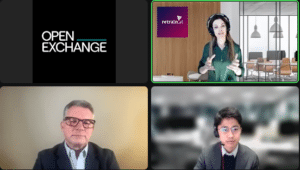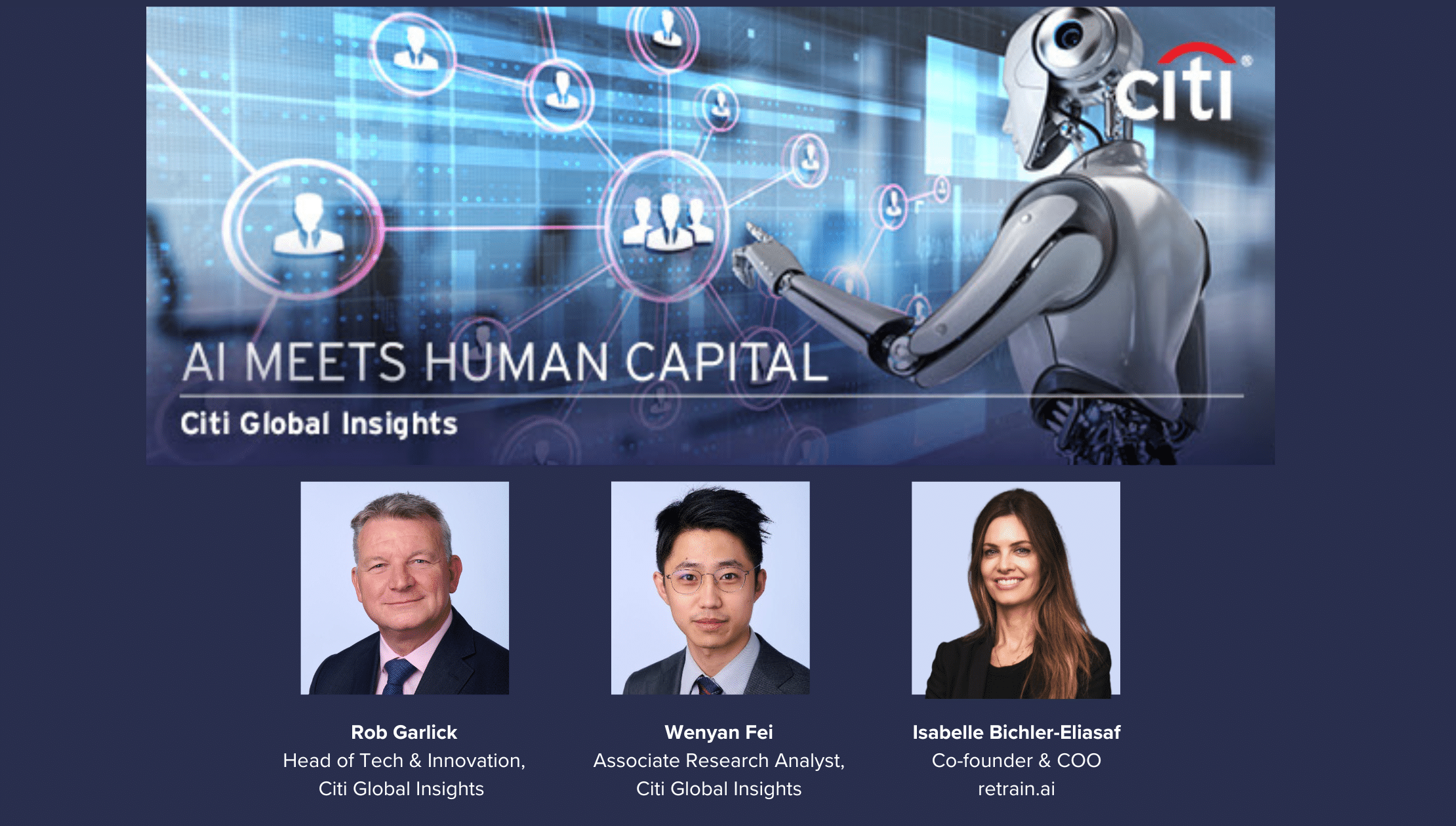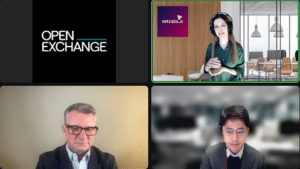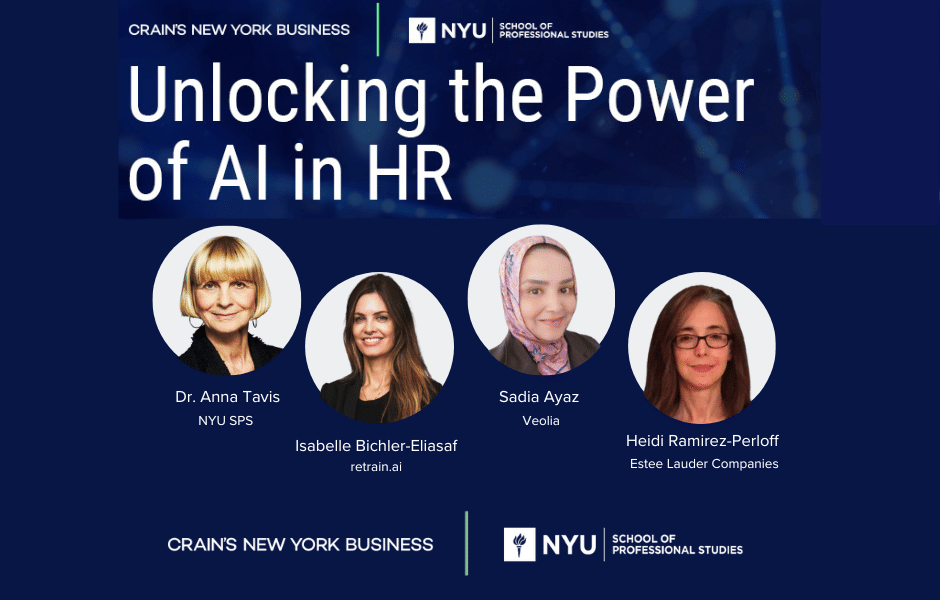retrain.ai Co-founder and COO Isabelle Bichler-Eliasaf was recently invited to speak with Rob Garlick and Wenyan Fei from Citi Global Insights for a webinar entitled “Are Talent Intelligent Platforms the Solution to Reskilling and Upskilling?”
Below is the second of a two-part blog series highlighting excerpts from their conversation. You can also view a recording of the full session here.

You mentioned that retrain.ai represents fifth-generation AI. Can you share with us some unique features enabled by this latest generation of AI and what differentiates your platform versus other providers?
Yes, for sure. It’s really honing in on the skills taxonomies we’re creating; retrain.ai built one of the biggest data assets that exists today. We’re bringing a holistic solution from hire to retire, but the first thing you need to do is start with the skills architecture model. It uses the robustness of skills taxonomies to see details and skills, quickly analyzing all the roles of an organization. We’re providing a complete, dynamic catalog to our customer so they can have all their roles analyzed by skills–technical skills, soft skills, hard skills, and so forth. They have an understanding of the skills that are in demand, emerging skills, those that are declining, etc. This is the first step; really building the foundation in order to add on the next floor which is going to be talent acquisition or talent management and so forth.
What we found is that a lot of organizations don’t do all that; the problem is that they operate in silos, without a unified skills language. They don’t share the same philosophy and the same strategy across teams. But cross-functional strategy should be shared because they’re going to use the same foundation of skills, the same framework. So what we’re doing at this stage is consolidating and synchronizing all teams in the same language. We’re taking the LMS skills framework and adapting it to the HCM and all the others used in an organization. That’s the first step, and now with that accurate, granular, robust skills data, I can inform talent acquisition; I can quickly create a job description based on the skills that I’ve analyzed for that role. Then I’m able to analyze the skills of your people; I can generate a heat map to understand what skills and organizational capabilities you have, and the skills gaps that represent weaknesses in specific departments. The skills data is also going to serve for learning and development to understand what the top skills are, and what the emerging skills are to fill skills gaps.
You say you’re a technology company built on data. Can you walk us through the kind of data that you ingest and how you train your model? It must be a huge amount to get to the point where you need to be in order to add value to people. Does this just get better and better as you are able to train it?
Exactly. It’s learning constantly. And the more data you collect, the more accurate you get so you can generate those predictions. What we’ve done throughout our first two years of inception is build a database by collecting from job boards, Indeed, all those different job boards, job descriptions, and so forth. Just on LinkedIn, you have 400 million active users that you can learn from; what career pathways they’ve pursued, and what skills they have for their position. We ingest all of this, plus pre-built taxonomies from Europe and Canada, and we continue to increase with market data. You can add even more from sites like Udemy; what are the learning trends, and what topics are in demand? All of this together feeds into one data asset. That is really integrated intelligence because we integrate with HCMs and older systems of record, not replacing them but just making them smarter with data.
People are fearful about data privacy, algorithmic bias, bias in hiring, etc. How do we tackle this as a society? Is AI part of the solution or part of the problem? How are you guys doing that at retrain.ai in terms of responsible AI?
This is why I’m very passionate about responsible AI; because this is a problem and solution. AI is amazing. It’s like saying you’re not going to use electricity because there are risks. Of course you will, but you need to take some precautions. For us at retrain.ai, GDPR is what we’re embedding so that we’re compliant with the most stringent requirements. We’re also making sure all data we have is used with the consent of candidates; we know this because they chose to put their data online with all the information and informative disclosures involved.
There’s also new legislation around telling you that you’re going to be assessed by a machine and allowing you to opt out: Local Law 144 here in New York City. I actually submitted public comments on the law along with others and one thing they hadn’t figured out is, if I’m a candidate opting out, am I able to be fully assessed? Am I actually discriminated against because I’m choosing that AI not be used? We had an amazing conference with Commissioner Keith Sonderling of the Equal Employment Opportunity and we were talking about that; his take on it is that the law didn’t change anything that wasn’t already in place. It didn’t do anything new. It’s still saying you shouldn’t discriminate based on gender, ethnicity, age, and all those different parameters–there’s another entity performing that assessment. I agree with him, but I think that the fear of AI makes us more aware and want to limit it. So now we need to balance between innovation and regulation.




